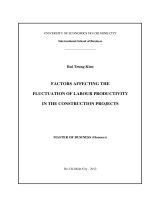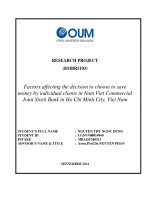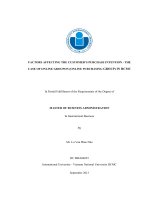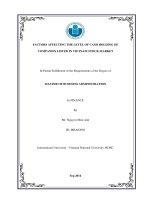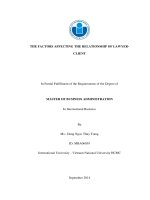Identify critical factors affecting the customer switching behavior for mobile service providers in vietnam
Bạn đang xem bản rút gọn của tài liệu. Xem và tải ngay bản đầy đủ của tài liệu tại đây (2 MB, 154 trang )
VIETNAM NATIONAL UNIVERSITY-HCM CITY
INTERNATIONAL UNIVERSITY
IDENTIFY CRITICAL FACTORS AFFECTING THE CUSTOMER
SWITCHING BEHAVIOR FOR MOBILE SERVICE PROVIDERS IN
VIETNAM
In Partial Fulfillment of the Requirements of the Degree of
MASTER OF BUSINESS ADMINISTRATION
In International Buisiness Major
By
Ms: Lam Thi Cam Tam
ID: MBA05036
Advisor: LE THANH LONG, PH.D
International University - Vietnam National University HCMC
August 2014
IDENTIFY CRITICAL FACTORS AFFECTING THE CUSTOMER
SWITCHING BEHAVIOR FOR MOBILE SERVICE PROVIDERS IN
VIETNAM
In Partial Fulfillment of the Requirements of the Degree of
MASTER OF BUSINESS ADMINISTRATION
In IB major
by
Ms: Lam Thi Cam Tam
ID: MBA05036
International University - Vietnam National University HCMC
August 2014
Under the guidance and approval of the committee, and approved by all its members,
this thesis has been accepted in partial fulfillment of the requirements for the degree.
Approved:
---------------------------------------------Advisor: Dr. Le Thanh Long
------------------------------------------Chairperson
---------------------------------------------Committee member
------------------------------------------Committee member
---------------------------------------------Committee member
------------------------------------------Committee member
Acknowledgement
I wish to express my deepest appreciation and gratitude to all the people that
have contributed to the completion of this dissertation. On the first line, I would like
to express my thanks to International University – Nation University as a whole,
especially the useful assistance and prompt feedback from teaching staffs and
officers as well. A lot of knowledge as well as many skills that I had not ever
possessed before have had from the MBA program almost two years.
I had a great fortune to study under supervision of Dr. Le Thanh Long. I am
very grateful for his guidance and encouragement. His profound knowledge provided
me with an opportunity to broaden my knowledge and to finish this thesis.
My gratitude is dedicated to my classmates and friends who always stand
beside one and give me the valuable support and recommendation.
Last but not least, special thanks also to my family for their ever-present love
and support.
Lam Thi Cam Tam
Ho Chi Minh 2014
i
LIST OF ABBREVIATION
Abbreviation
Equivalence
ARPU
Average revenue per user
CL
Customer lock-in
MSP
Mobile service provider
MNP
Mobile number portability
PP
Price
SC
Switching cost
SQ
Service quality
ii
Plagiarism Statements
I would like to declare that, apart from the acknowledged references, this
thesis either does not use language, ideas, or other original material from anyone; or
has not been previously submitted to any other educational and research programs or
institutions. I fully understand that any writings in this thesis contradicted to the
above statement will automatically lead to the rejection from the MBA program at
the International University – Vietnam National University Ho Chi Minh City.
ii
Copyright Statement
This copy of the thesis has been supplied on condition that anyone who
consults it is understood to recognize that its copyright rests with its author and that
no quotation from the thesis and no information derived from it may be published
without the author‟s prior consent.
© Lam Thi Cam Tam _ MBA05036
iii
Abstract
The target of this study is to identify the factors affecting switching behavior
in using the mobile service in Vietnamese subscribers. In the conceptual framework
model, there were six factors impact to switching behavior including price, service
quality, customer lock-in, switching cost collected in two group factors customer
satisfaction and switching barrier follow previous hypothesis. Demographic
characteristic relate to the level of impact behavior, it is associated with six factors
above as intervening variable were also hypothesized to affect switching behavior.
The target population for study was the subscribers in Ho Chi Minh City. The
author applied quantitative approach as the major method to conduct the study with
main statistic technique consisting factor analysis, regression, path analysis. The
result found from the study provided clearer understanding for mobile service
providers in Vietnam bases on the experimental evidence. It gets whole information
from mobile subscribers shown that switching behavior was directly affected by
price, switching cost and indirectly by customer satisfaction. Besides, the switching
behavior was also indirectly affected by relationship demographic features.
With a full overview of switching behavior in telecommunication services in
Vietnam, discovering factors impact to switching behavior will be a premise for
building strategic marketing and new development of products that Vietnamese
providers. From that, plans face with potential competition risk from foreign
competitor in future is being prepared.
Keywords: switching behavior, mobile services provider, satisfaction failure,
alternative attractiveness, brand attractiveness, social influences, switching barrier,
and perceived switching cost.
iv
v
Table of Contents
Contents
List of Tables............................................................................................................... ix
List of Figures ............................................................................................................. xi
Chapter 1 - INTRODUCTION .................................................................................... 1
1.1. Background of the study .................................................................................. 1
1.2. Telecommunication industry in Vietnam ......................................................... 2
1.3. The Problems statement ................................................................................... 4
1.4. Objectives ......................................................................................................... 6
1.5. Rationale........................................................................................................... 7
1.6. Scope of research ............................................................................................. 8
1.7. Thesis structure ................................................................................................ 9
Chapter 2 – LITERATURE REVIEW ....................................................................... 12
2.1. Switching behavior.......................................................................................... 12
2.2. Impact of switching behavior .......................................................................... 13
2.3. Factors can affect to switching behavior ......................................................... 15
2.4. Conceptual framework model for the research ............................................... 22
Chapter 3 – RESEARCH METHODOLOGY ........................................................... 25
3.1. Research method ............................................................................................. 25
3.2. Research sample .............................................................................................. 25
3.3. Research Methodology.................................................................................... 27
3.4. Data collection ................................................................................................ 30
3.5. Data analysis Techniques ................................................................................ 32
3.5.1. Descriptive statistics ................................................................................ 32
3.5.2. Factor analysis ......................................................................................... 33
vi
3.5.3. Multiple regression .................................................................................. 33
3.5.4. Path analysis ............................................................................................ 33
3.6. Validity Test .................................................................................................... 34
3.6.1. Factor analysis for independent variable ................................................ 34
3.6.2. Factor analysis for Dependent variable .................................................. 37
Chapter 4 - DATA ANALYSIS AND ACHIEVED RESULTS ............................... 41
4.1. Demographic characteristic of the sample ...................................................... 41
4.2. Reliability Test ................................................................................................ 46
4.3. Descriptive statistics of variable ..................................................................... 48
4.4. Factor analysis to Switching behavior ........................................................... 50
4.4.1. Multiple regression .................................................................................. 50
4.4.2. Factor affects to customer satisfaction .................................................... 51
4.4.3. Factor affects to switching barrier .......................................................... 54
4.4.4. Factor affects to switching behavior ........................................................ 55
4.5. Direct and indirect effects of independent on switching behavior ................. 57
Chapter 5 - Conclusions and recommendations ......................................................... 61
5.1. Conclusions ..................................................................................................... 61
5.1.1. Problem recognized from the result of the research ................................ 62
5.1.2. Relationship between switching behavior with influence factors ............ 65
5.1.3. Recommendation ...................................................................................... 68
5.3. Business strategies implies.............................................................................. 70
5.2. Research limitation.......................................................................................... 71
5.4. Suggestions for future research ....................................................................... 72
References .................................................................................................................. 74
APPENDIX A (English Questionnaires) ................................................................... 80
vii
APPENDIX B (Vietnamese Questionnaires) ............................................................. 86
APPENDIX C (Cronbach‟s Alpha) ........................................................................... 92
APPENDIX D (Factor loading) ............................................................................... 114
APPENDIX E (Regression Analysis) ...................................................................... 129
viii
List of Tables
Table 3. 1: KMO and Bartlett's Test for Independent variables ................................ 34
Table 3. 2: Total Variance Explained for Dependent variables ................................. 35
Table 3. 3: Rotated Component Matrix of Independent variables ............................. 36
Table 3. 4: Reliability coefficients of Independent variables arrange follow
components ................................................................................................................ 37
Table 3. 5: KMO and Bartlett's Test for Dependent variables ................................... 37
Table 3. 6: Total Variance Explained for Dependent Variables ................................ 37
Table 3. 7: Reliability Coefficients of Dependent Variables ..................................... 38
Table 3. 8: Rotated Component Matrix of Dependent variables ............................... 39
Table 4. 1: Trends 3G on mobile internet .................................................................. 46
Table 4. 2: Interpreting strength of Pearsons correlation ........................................... 47
Table 4. 3: Reliability Coefficients of Independent Variables ................................... 47
Table 4. 4: Reliability Coefficients of Dependent Variables ..................................... 48
Table 4. 5: Descriptive Statistics of Independent variables ....................................... 48
Table 4. 6: Descriptive Statistics of dependent variables ......................................... 49
Table 4. 7: Pearson correlation between independent variables ................................ 51
Table 4. 8: Correlation coefficients between independent variables and its dependent
variables ..................................................................................................................... 52
Table 4. 9: ANOVA results on effect of independents on Customer satisfaction ..... 52
Table 4. 10: Correlation coefficients between independent variables and switching
barrier ......................................................................................................................... 54
Table 4. 11: ANOVA results on effect of independents on switching barrier ........... 54
ix
Table 4. 12: Description and variables‟ Correlation of independents on switching
behavior ...................................................................................................................... 55
Table 4. 13: ANOVA results on effect of intermediate variables on switching
bahavior ...................................................................................................................... 56
Table 4. 14: Coefficients between dependent variable and SWB .............................. 56
Table 4. 15: Description and variables‟ Correlation of independents on switching
behavior ...................................................................................................................... 57
Table 4. 16: ANOVA of independents on switching behavior .................................. 58
Table 4. 17: Coefficients between the independent variable and SWB ..................... 59
x
List of Figures
Figure 1. 1: Market shares (subscribers) of mobile phone service providers .............. 3
Figure 1. 2: The growth of mobile subscribers in Vietnam from 2004 to 2013 .......... 4
Figure 2. 1: Suggested model ..................................................................................... 23
Figure 3. 1: Progress of researching........................................................................... 31
Figure 4.1: Ratio respondents about providers .......................................................... 42
Figure 4. 2: Distribution follows charge form ........................................................... 42
Figure 4. 3: Distribution rate of Subscriber base on gender ...................................... 43
Figure 4. 4: Distribution rate of Subscriber base on age ............................................ 44
Figure 4. 5: Distribution rate of Subscriber base on income...................................... 44
Figure 4. 6: Distribution rate of type of career........................................................... 45
Figure 4. 7: Number of subscriber distributed on education background of total
sample ........................................................................................................................ 46
Figure 4. 8: The practice model of switching behavior ............................................. 60
xi
Chapter 1 - INTRODUCTION
1.1.
Background of the study
Nowadays, there have been many mobile providers with many different
service packages given consumers in Vietnam, so Vietnamese consumers have many
solutions for choosing mobile providers. In order to receive the best service and
maximizing the benefit, satisfaction and minimizing the cost, the consumer usually
considers changing more suitable mobile service providers (MSPs). It has increased
the pressure of MSPs which must supply services creating satisfaction for their
customers to remain and attract customers back or switch to their brand. Moreover,
the upcoming introduction of mobile number portability (MNP) to control all mobile
subscribe by the government will to emphasize the appearance of a transition period
in the mobile telecommunication services market.
Therefore, understanding and evaluating what affect customer switching
behavior is important. Because a customer‟s switching behavior results in the loss of
the future revenue stream from that customer. In particular, switching by a service
customer is a loss for a firm‟s high-margin sector of its customer base (Depend Liang,
2012). The cost associated with acquiring new customers, including account setup,
credit check, and promotion expenses, can be as much as five times the cost of
customer retention efforts (Keaveney, 1995; Peter, 1998). From that, explaining
customer behavior why customers choose to stay or switch to their mobile service
provider (MSP) in Vietnam become an essential topic for researching.
1
1.2.
Telecommunication industry in Vietnam
Beginning with a mobile provider in Mobifone brand in 1993, telecommunication
in Vietnam officially flow with at telecommunication industry in the world. By itself
contribution, Mobifone or mobile service in general in Vietnam opened a new age of
information and communication technology plays a role of infrastructure platform to
create tools and utilities for developing other sectors as well as improving quality of
people's life. Telecommunications has been seen as one of the major factors
promoting economic growth in Vietnam. It has proven to be a positive role in
promoting development of socio - economic structure, community life and activities
of organizations and individuals. .
Although formed later than other countries in the region and the world, the
mobile telecommunications market in Vietnam developed to a breakneck speed in
recent years. Appearance of Vinaphone brand in 1997 created multiform choices of
customers with mobile provider services. In 2000, with Viettel brand opened a
competitive period on the Vietnam telecommunication market. A small wave of
subscribes moved from Mobifone to Vinaphone, from Mobifone to Viettel, from
Vinaphone to Viettel besides increasing amount of new subscribes of these providers.
With one mobile network from the early days, there have been six MSPs on the
market.
Furthermore, with the growth of mobile technology faster, shorten cycle
technology, cost advantages due to declining investment is a challenge with the old
MSP Vinaphone. It broke the single position of Vinaphone. With 6 competitors on the
market which apply primarily policies on price cuts and promotions constantly, it has
made a wave of subscribes move from one provider to another or using many
numbers of many providers at the same time becoming more and more popular
2
phenomenon. This situation shows that switching behavior of customer is the
necessary note to providers.
For a long time, the mobile network in Vietnam has developed in the race of
increasing the number of subscribers. The account of subscribes base reached 140
million threshold at the present. But the area of growth has slowed in width, while in
2012, only incurring 12 million subscribers. The market seems saturated and the
network operators are turning to non-voice services on 3G services to increase
revenue. Beside there are a phenomena of switching behavior among of providers in
Vietnam from 2009 to now. Figure 4 presented that:
Figure1. 1: Market shares (subscribers) of mobile phone service providers
(Source: White book of Vietnam 2010, 2011, 2012, 2013)
In the context of countries which the mobile telecommunications market
appearing strong competition and open markets significantly reduced the advantage of
monopoly position, with the involvement of multiple vendors, using the competitive
strategy mixed strategies including rates, quality basic services, value added services ,
advertising promotions, discounts and customer care, replacement services OTT,
giving them more and more choices, with moving to another provider which are more
3
attractive than sustainable impact on the subscriber‟s mobile networks. Mobile
telecommunications market in Vietnam is in fierce competition with the faster growth
of mobile technology shorten cycle technology, cost advantages due to declining
investments, which has resulted in the opportunity for new service providers to enter
the market, and the challenge for service providers present. Therefore, more and more
customers have more choice, it is also means that businesses will face many
difficulties in retaining patrons and attract new users to the service.
Deputy Minister Le Nam Thang said previously the number of subscribers in
Vietnam is estimated over 160 million. But as soon as the MIC policy prohibits the
sale of SIM account with the development of the new subscriber network has been
significantly reduced. Currently only 91 million subscribers and charges incurred
numbers used here is consistent with the current market.
1.3.
The Problems statement
The ratio of 145 million subscribers/100 people in Vietnam (2012 and over
15.5 million 3G subscribers-the statistics from Wireless Intelligence) is considered as
the ratio of saturated mobile subscribers (Figure 1).
Figure1. 2: The growth of mobile subscribers in Vietnam from 2004 to 2013
(Source: White book 2013)
4
Therefore, the expansion of the market through increasing the number of
subscribers is hard work. Currently, the number of subscribers currently reached
saturation point and no longer charges for its own advantage. Any business attempting
to find and create new customers will meet difficulties and have to spend more on
advertising forever. Therefore, whether these customers stay or switch to another
subscribers will not only vital but also be a competitive advantage of each particular
mobile network.
The flows of wave of moving mobile subscribers to the providers to the other
providers has been repeated in telecommunication industry in Vietnam after each
campaign on promoting of providers. From 2008 to 2012, the amount of the
Vinaphone‟s subscribers switched from Vinaphone provider to Viettel provider by the
cheap policy of Viettel. However, there has been a change in the number of
subscribers switching from Vinaphone, Mobifone or Vietnammobile to Viettel when
these providers change competitive strategy in many efforts of making something
different.
Facing with an increasing rate of customer defection, giant wireless service
providers have directed a relentless flood of pitches, including free phones, upgrades,
and free minutes to „„sweeten the deal‟‟ and lock-in customers. However, assuming
that customer defection can be controlled by providing financial incentives is
fundamentally flawed. There is no research evidence to suggest that customer loyalty
is driven by financial incentives. On the contrary, extant literature indicates that
customer loyalty is in fact driven by a multitude of interrelated factors. Therefore, a
solid understanding of these factors must proceed „„intervention‟‟ strategies aimed at
curtailing customer defection. Hence, the purpose of this research is to develop and
test a model that aids further understanding of the determinants of switching behavior
5
in the mobile telecommunication industry. Such a model will have significant
strategic implications for firms in this intensely competitive industry.
The biggest challenge faced by telecommunication industry is the process of
leaving one mobile phone provider for another. Therefore, losing a customer is a
serious setback for the firm of losing the benefits. Then, the firm needs to invest
resources in attracting new customers to replace the ones it has lost by advertising,
promotion, initial discounts. Peter and Verhoef (2001) shows that it can cost five
times more to acquire a new consumer than to retain an old one. Consequently,
retaining the current consumer base is much more attractive than searching for new
consumers
Recognizing the importance of the issue, I decided to select and research
topics: “Identify critical factors affecting the customer switching behavior for
mobile service providers in Vietnam”.
1.4.
Objectives
In fact, the factors affecting customer switching behavior for mobile phone
service in Vietnam will be an urgency and immense significance not only for each
mobile network particular activities, but also for mobile communication industry in
our country to answers to question: “How to keep AND attract Vietnamese
customer in telecommunication sector, nowadays?”
With the target above issues, this research will examine consumer‟s behavior
switching to use telecom services from Vietnamese by:
Finding out which factors influent to Vietnamese‟s switching behavior to
mobile service providers.
Finding out which key factors can affect mostly to switching behavior to
mobile services to providers in Vietnam.
6
The purpose of the research is to contribute for evaluate impacts and tendency
about behavior switching:
-
What to do growth up customers‟ believe and factors that affect
customer behavior in staying or switching with a MSP? Particular
attention is the reasons why they matter for telecommunications
providers, this topic will be discussed by identifying variables have
impact switching behavior in choosing any MSP.
-
Which factor focus on customer churn (customers‟ decision to leave a
service provider)?
The main findings of the analysis will be presented along with the conclusions,
including recommendations to MSPs based on an improved understanding of the
factors affecting customers‟ propensity to stay with a provider or switch to another.
From that, specific intervention strategies of network operators in Vietnam suggested
with the adjustment marketing solutions for telecommunication services to remain and
keep customers in the next years out of potential foreign providers when Vietnam
implements full WTO agreements in 2015.
1.5.
Rationale
In the telecommunications services market, especially the market share of
mobile, there is always have high growth rates despite the economic crisis.
Vietnamese users are evaluated adapt to technology quickly, and increasing routine
use data services on mobile when there are the active support of the growth of cheap
smartphone devices. Supposing that consumers spend value-added services related to
mobile data on the mobile will be increasing, it is more important that they always
want to stay with a provider. Research all the factors affecting the consumer behavior
of mobile data services should be done in order to find out what factors can influence
7
the consumer stimulus Vietnam and keep major providers for them. There will be
solutions helping to develop business strategy suitably with the trend and increasing
customers for telecommunication service providers. So:
-
The research carried out will contribute a more complete picture of
consumer perceptions of the mobile data services and consumer
motivation it clearer and more realistic.
-
Research results are one of the few references to the agencies in planning
management policies to develop mobile services in depth, ensure quality,
meet the requirements of use, confirmed the ability to compete with free
data services on the Internet.
-
Research results such as an image reflect the desire of the customers or
the business units in the practice view really taking place. Having a
looking at it may bring a key factor of growth, what factors constraining
the acceleration of data services mobile broadband in Vietnam. Since then,
these telecom companies have the facility to build plans, packaging
solutions in business operations per unit.
1.6.
Scope of research
The research scope will be collected the information from the major city is Ho
Chi Minh City. Because, Ho Chi Minh city is the area which has the largest density of
mobile subscribers, full of providers, the adaptation with a rapid speed of the oriented
consumer changing. And, objects get survey is mobile phone subscribers from 16 ages
to 60 ages. At the age, the demand of consumers can use telecommunication services
and adapt regular of owning mobile phone subscriber by individual identity.
In figure 1 (Chapter 1) showed a clarity shift, change or disappear with the
appreciable amount of subscriber of providers in the period from 2011 onwards.
8
Besides, in figure 2 (Chapter 1) also displayed a rate of slowdown increasing with the
number of mobile subscribers from 2012 onwards. Another way to increase the
number of mobile subscribers in Vietnam in terms of overall telecom sector will not
be as powerful as the previous year. The growth of each provider will focus on the
movement of subscribers from provider to another provider. The wave of conversion
occurs when providers have impact factors. It could be price, service quality,
decreased switching barrier. Each provider has its own strategy to attract customers
on the basis of the impact of different behaviors. As a result the study of impact to
switching behavior will be considered for any subscribers of all providers in the
purpose of the fully assess all impacts of the switching behavior of mobile subscribers
in Vietnam...
Collecting data with survey questions is considered as the primary data.
Reference from secondary data such as: reports or annual report of Vietnam
Information and Communication Technology - White Books, statistic data of
telecommunication companies in Vietnam will add for studying.
1.7.
Thesis structure
The organization of the study includes five chapters. In which, chapter 1
comprised the general overview of problems of the study have been taken care. This
chapter also answers the question what motivates the author to carry out this research.
The research purpose, scope and implication of the research were made clearly as well.
Chapter 2 will give whole the base of literature review related to switching
behavior. In this chapter, the author will introduce some model of factors which affect
to switching behavior in telecom sector of many Asian countries from many
researchers. By comparing and analyzing base on these review researches, the author
9
will give a model of suitable factors which its adoption to measure in Vietnamese
mobile subscribers.
Chapter 3 is the presentation about the research method, the way that the study
will be conducted. The method was built with integrated approach between qualitative
methods and qualitative methods. However, the quantitative method was the major
method of the research. The theoretical basis and data base of a telecommunications
service sector is fragment of theoretical model recommended. In this section,
questionnaire design, unit of analysis, sample size and measureable scale will be
clearly indicated.
Chapter 4 is the report of the analyzed data and the result from them. This
chapter recorded the main concern about finding from the practice data by statistical
techniques as descriptive statistics, reliability, explanatory factor analysis, correlations,
multiple regression and path analysis. It is the conclusion for the suitability of the
model suggested with real influenced factors on switching behaviors of mobile
subscriber.
Chapter 5, the final section will give the link of existing laws of the telecom
service market through surveys and reports in the chapter 4. From that, it will be
integrated with the other reports of trends of the market in future to provide a closer
view about current situation. And more important, once research questions had been
answered and research hypothesis had been testified, the author implicated a
suggested suitable developing strategies for remain mobile subscribers in Vietnam.
Since then, the author has proposed some solutions to adapt the new trend in the
market towards MSPs in Vietnam.
Chapter summary
10
This chapter is considered very important as the first step of study that
provides the overview of the dissertation. It starts with background relating to
switching behavior of mobile subscribers in the Vietnam context with a trend of the
high competition. The competition will be stronger and stronger when the MNPs
policy (keeping the number of subscriber not switch another provider) applied in 2017.
Platform of the research based on literatures supplied in chapter 2 related to switching
behavior in the telecommunication sector.
11



